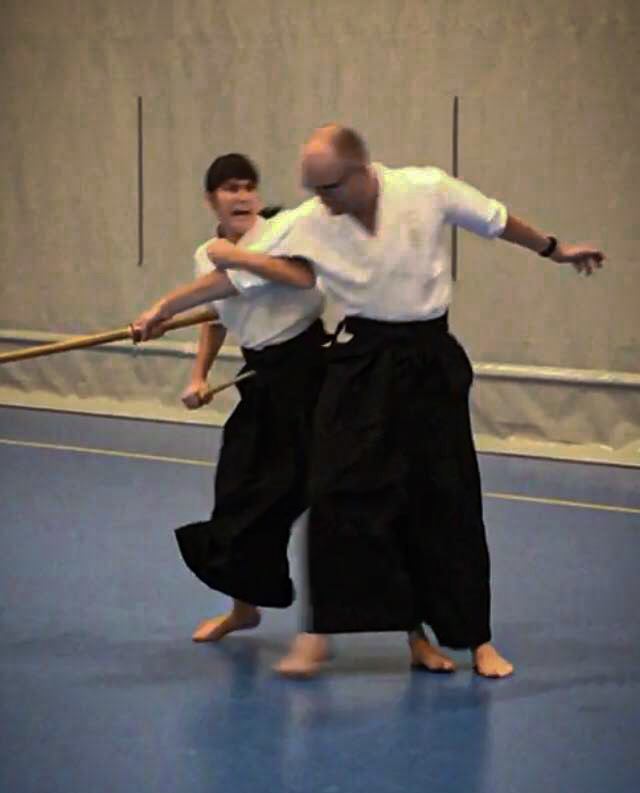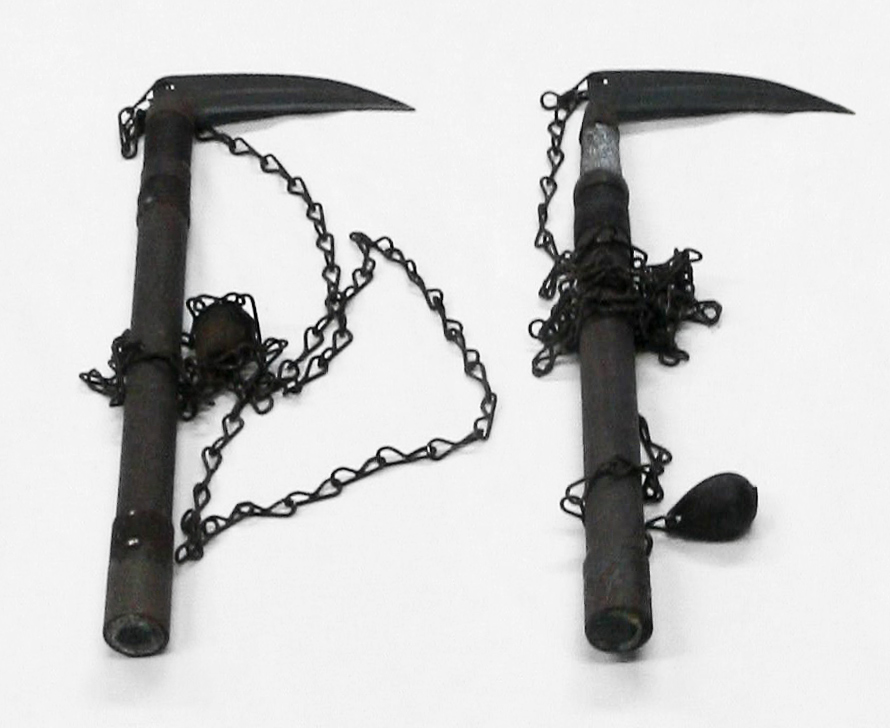|
Bugei JÅŦhappan
The Bugei jÅŦhappan (æĶčļåå ŦčŽ "Eighteen Kinds Of Martial Arts") is a selection of combat techniques and martial arts used by the samurai of Tokugawa-era Japan. Established by Hirayama Gyozo, the concept is based on earlier Chinese traditions, such as Eighteen Arms of Wushu. Eighteen arts 300px, 1. KyÅŦjutsu 300px, 2. Bajutsu The Eighteen Arts consist of a mixture of native Japanese and imported Chinese martial art techniques and tactics. Within each art, various ''RyÅŦ'' developed, with different methods of performing that particular art. Certain ''RyÅŦ,'' in turn, influenced the martial arts that were included in the list, Asayama Ichiden-ryÅŦ, Kukishin-ryÅŦ, Shinden-Fudo-ryÅŦ and Tagaki Yoshin-ryÅŦ. The exact list varies, but is commonly held to include: # ''KyÅŦjutsu'', archery. # ''Bajutsu'', horseriding. # ''SÅjutsu'', fighting with a ''yari'' (spear). # ''Kenjutsu'', fencing. # '' Suieijutsu'', swimming in armour. # ''Iaijutsu'', sword-drawing. # ''TantÅ ... [...More Info...] [...Related Items...] OR: [Wikipedia] [Google] [Baidu] |
Martial Arts
Martial arts are codified systems and traditions of combat practiced for a number of reasons such as self-defense; military and law enforcement applications; combat sport, competition; physical, mental, and spiritual development; entertainment; and the preservation of a nation's intangible cultural heritage. Etymology According to Paul Bowman, the term ''martial arts'' was popularized by mainstream popular culture during the 1960s to 1970s, notably by Hong Kong martial arts films (most famously those of Bruce Lee) during the so-called "chopsocky" wave of the early 1970s. According to John Clements, the term '':wikt:martial art, martial arts'' itself is derived from an older Latin (language), Latin term meaning "arts of Mars (mythology), Mars", the Roman mythology, Roman god of war, and was used to refer to the combat systems of Europe (European martial arts) as early as the 1550s. The term martial science, or martial sciences, was commonly used to refer to the fighting arts of E ... [...More Info...] [...Related Items...] OR: [Wikipedia] [Google] [Baidu] |
Tantojutsu
TantÅjutsu (įåčĄ) is a Japanese term for a variety of traditional Japanese knife fighting systems that used the tantÅ (įå), a knife or dagger. Historically, many women used a version of the tantÅ, called the kaiken, for self-defense, but warrior women in pre-modern Japan learned one of the tantÅjutsu arts to fight in battle. Martial arts that practise tantÅjutsu TantÅ with blunt wooden or plastic blades are used to practice martial arts. Metal blades can be used in more advanced training and in demonstrations. Styles that use tantÅ: BudÅ (Gendai): * Aikido * Shorinji Kempo Bugei: * Yanagi-ryu Aiki Bugei Bujutsu (KoryÅŦ): * Kashima Shin-ryÅŦ (this '' ryÅŦha'' uses term Kaikenjutsu) * Takamura-ha Shindo Yoshin-ryu See also * Kaiken (dagger) * Wakizashi The is one of the traditionally made Japanese swords (''nihontÅ'') worn by the samurai in feudal Japan. History and use The production of swords in Japan is divided into specific time periods: [...More Info...] [...Related Items...] OR: [Wikipedia] [Google] [Baidu] |
Ninjutsu
, sometimes used interchangeably with the modern term , is the martial art strategy and tactics of unconventional warfare, guerrilla warfare and espionage purportedly practised by the ninja. ''Ninjutsu'' was a separate discipline in some traditional Japanese schools, which integrated study of more conventional martial arts (''taijutsu'') along with ''shurikenjutsu'', ''kenjutsu'', ''sÅjutsu'', '' bÅjutsu'' and others. While there is an international martial arts organization representing several modern styles of ''ninjutsu'', the historical lineage of these styles is disputed. Some schools claim to be the only legitimate heir of the art, but ''ninjutsu'' is not centralized like modernized martial arts such as judo or karate. Togakure-ryÅŦ claims to be the oldest recorded form of ninjutsu, and claims to have survived past the 16th century. History Spying in Japan dates as far back as Prince ShÅtoku (572â622). According to ShÅninki, the first open usage of ''ninjutsu'' ... [...More Info...] [...Related Items...] OR: [Wikipedia] [Google] [Baidu] |
Kusarigama
A is a traditional Japanese weapon that consists of a ''kama'' (the Japanese equivalent of a sickle or billhook) on a kusari-fundo â a type of metal chain (''kusari'') with a heavy iron weight (''fundo'') at the end. The ''kusarigama'' is said to have been developed during the Muromachi period. The art of handling the kusarigama is called ''kusarigamajutsu''. History The researcher Nawa Yumio believes that the ''kusarigama'' was based on the ''jingama'', a tool that resembles a sickle, which was used to cut through a horse's ropes in the case of a fire. The ''jingama'' could also be used as a weapon and according to Nawa, the tool might have been combined with a ''konpi'' (æĢéĢ) which is a chain that contained a weighted end and a chain around the user's wrist. People would wield the weapons with both hands to protect their horses against criminals. Another theory is that the ''kusarigama'' is based on the ''tobiguchi'' ( :ja:éģķåĢ), which is a type of axe that had a "stou ... [...More Info...] [...Related Items...] OR: [Wikipedia] [Google] [Baidu] |
Kusarigamajutsu
is the art of using the Japanese weapon kusarigama. Kusarigamajutsu is featured in several separate martial arts such as TendÅ-ryÅŦ, SuiÅ-ryÅŦ and ShintÅ MusÅ-ryÅŦ. The kusarigama is made up of three parts: the ''Kama (weapon), kama'' (a wooden handle with a curved blade (traditionally straight) protruding at a right-angle on one end, and a small loop at the other), and the ''kusari'' (a chain attached to the kama) and a weight at the end of the chain. In a confrontation the kusari is swung in wide sweeping arcs to distract and entangle the opponent and the kama is used to deliver a fatal strike. Martialartsaus.com. Accessed June 2, 2012. Popular culture * ''Teenage Mutant Ninja Turtles'' features kusarigamajutsu being used by Michaelangelo (Teenage Mutant Ninja Turtles), Michaelangelo and L ...[...More Info...] [...Related Items...] OR: [Wikipedia] [Google] [Baidu] |
Jujutsu
Jujutsu ( ; ja, link=no, æčĄ , ), also known as jiu-jitsu and ju-jitsu, is a family of Japanese martial arts and a system of close combat (unarmed or with a minor weapon) that can be used in a defensive or offensive manner to kill or subdue one or more weaponless or armed and armored opponents. Jiu-jitsu dates back to the 1530s and was coined by Hisamori Tenenouchi when he officially established the first jiu-jitsu school in Japan. This form of martial arts uses few or no weapons at all and includes strikes, throws, holds, and paralyzing attacks against the enemy. Jujutsu developed from the warrior class around the 17th century in Japan. It was designed to supplement the swordsmanship of a warrior during combat. A subset of techniques from certain styles of jujutsu were used to develop many modern martial arts and combat sports, such as judo, aikido, sambo, ARB, Brazilian jiu-jitsu, and mixed martial arts. The official date of foundation of Jiu Jitsu is 1530. Charac ... [...More Info...] [...Related Items...] OR: [Wikipedia] [Google] [Baidu] |
Naginata
The ''naginata'' (, ) is a pole weapon and one of several varieties of traditionally made Japanese blades (''nihontÅ''). ''Naginata'' were originally used by the samurai class of feudal Japan, as well as by ashigaru (foot soldiers) and sÅhei (warrior monks). The naginata is the iconic weapon of the onna-musha, a type of female warrior belonging to the Japanese nobility. Naginata for fighting men and warrior monks were ''Å-naginata'' (åĪ§čå). The kind used by women were called ''ko-naginata'' (å°čå). Description A ''naginata'' consists of a wooden or metal pole with a curved single-edged blade on the end; it is similar to the Chinese guan dao or the European glaive. Similar to the katana, naginata often have a round handguard (''tsuba'') between the blade and shaft, when mounted in a koshirae (furniture). The 30 cm to 60 cm (11.8 inches to 23.6 inches) ''naginata'' blade is forged in the same manner as traditional Japanese swords. The blade has a long tang ... [...More Info...] [...Related Items...] OR: [Wikipedia] [Google] [Baidu] |
Naginatajutsu
is the Japanese martial art of wielding the . The naginata is a weapon resembling the medieval European glaive and the Chinese guan dao. Most naginatajutsu practiced today is in a modernized form, a ''gendai budÅ'', in which competitions also are held. History Origins The ''naginata'' originates from development of the Japanese spear called ''hoko yari'' of the later 1st millennium AD. It has been suggested that it developed along the same lines as Okinawan kobudÅ weapons as a modified farming tool. Others say that creative samurai in need of a longer weapon attached a sword to a pole. Perhaps the simplest explanation is the natural development of polearms. Polearms are intended as mass weapons, to be used not just by individual warriors, but by formations of soldiers together on field battles and not for dueling. When fighting in close order, two-handed cut-and-thrust weapons, such as halberds and glaives, are much more efficient than mere spears or swords because of their ... [...More Info...] [...Related Items...] OR: [Wikipedia] [Google] [Baidu] |
Shuriken
A ''shuriken'' ( ja, æčĢåĢ; literally: "hidden hand blade") is a Japanese concealed weapon that was used as a hidden dagger or metsubushi to distract or misdirect. They are also known as throwing stars, or ninja stars, although they were originally designed in many different shapes. The major varieties of shuriken are the and the or . Shuriken were supplementary weapons to the sword or various other weapons in a samurai's arsenal, although they often had an important tactical effect in battle. The art of wielding the shuriken is known as shurikenjutsu and was taught as a minor part of the martial arts curriculum of many famous schools, such as YagyÅŦ Shinkage-ryÅŦ, Tenshin ShÅden Katori ShintÅ-ryÅŦ, IttÅ-ryÅŦ, Kukishin-ryÅŦ, and Togakure-ryÅŦ. Bo-shuriken A ''Bo-shuriken'' is a throwing weapon consisting of a straight iron or steel spike, usually four-sided but sometimes round or octagonal in section. Some examples have points on both ends. The length ranges from 1 ... [...More Info...] [...Related Items...] OR: [Wikipedia] [Google] [Baidu] |
.jpg)



